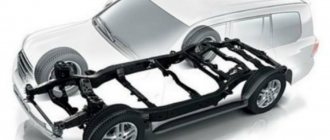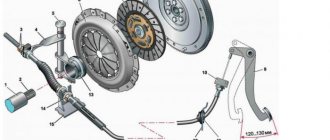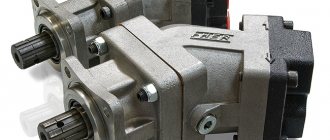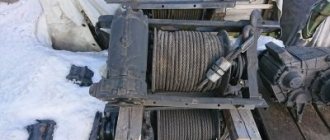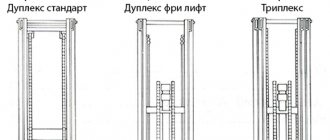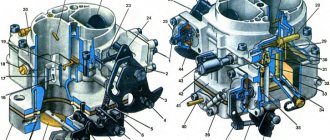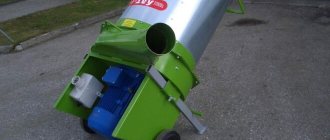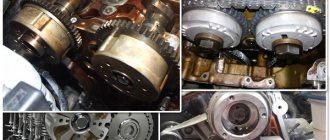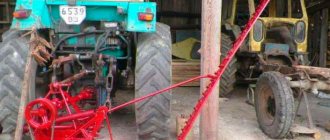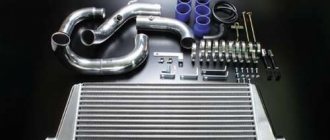Let us continue to examine in detail the device and design of the car. Let's dwell on what the frame, body and chassis of a vehicle are. Let's focus on their main purpose.
- The frame
is a supporting structure. This is the basis for other parts of the vehicle. Its frame. The engine, suspension, transmission units (mechanisms used to transmit motion) and other components of the car are attached to the frame. Initially, all cars had a frame. Now - only for those without a supporting body. These are trucks, most SUVs. Frames can be spinal (load-bearing parts - pipes) or consisting of spars (they are made from channels - metal products that form the letter “P” in cross section). Backbone frames are more rigid, and the torsional rigidity of the frame is especially impressive. Based on the backbone frame, it is easy to create a car with a different number of drive axles. But modern manufacturers use spar frames more often. After all, when using a backbone frame, the mechanisms have to be installed inside it, and if the machine breaks down, repairs are very difficult. - The body
is the frame of the car. It is a constructive part. It can be attached directly to the frame or represent an independent supporting system (for models where the frame is not installed - mainly passenger cars). Made from metal (e.g. sheet steel, aluminum), carbon fiber, plastic, fiberglass. Designed to accommodate the driver, passengers and cargo. The body includes a number of components: hood, fenders, running boards. The number and types of components depend on which vehicle the body belongs to. For example, in a commercial (truck) vehicle, the body can be represented by the “formula” cab + platform/tank/van + fenders, hood, steps, while the body of a passenger vehicle is more often represented by the base, roof, side, front and rear panels (side, front and back). To protect against corrosion and give an aesthetic appearance, the car body is painted. - Chassis
is a set of chassis components, control mechanisms and transmission. Thus, behind the chassis there are all the units and components that are needed to control the movement of the vehicle. It is the units and chassis components that provide the vehicle with the transmission of driving force. Such qualities as, for example, maneuverability and load-carrying capacity of the vehicle depend on the chassis.
Body and frame chassis
If we are talking about a chassis on a frame, this is a complete structure that can be moved on its own wheels or tracks. Frame chassis are installed on trucks and tractors. At the same time, means of increasing cross-country ability can be installed on the chassis of vehicles intended for movement in off-road conditions.
If we are talking about the chassis of a vehicle with a monocoque body, then we are dealing with the base of the vehicle. It is this that is the connecting link between the chassis units and control mechanisms.
One of the popular design options is the full-frame “body over frame” system. This is a rigid structure made of steel rods. Auto mechanics use bolts for fastening. This design is especially suitable for jeeps and minibuses.
A chassis with a monocoque body (the connection is made by welding) can more often be found in small and medium-sized passenger cars. Many body structures of this type are called unified, block.
Compared to a frame structure, the body structure has significantly less weight. Thanks to this, body vehicles have better fuel efficiency.
The figure clearly demonstrates that body vehicles do not have a separate frame. The supporting body of the vehicle is formed by panels.
A – Body structure with removable chassis.
B – Chassis components. Typical layout for Mazda and SAAB cars. The components are fastened to the metal parts of the body structure through reinforced transverse elements.
It is also important to be familiar with the concept of “self-propelled chassis”. In this case, we are not talking about a component, but an independent motorized vehicle. Additional equipment, tools, devices (welding machine, mounted combine harvester, snowblower, loader, hoist, truck crane) are installed on the self-propelled chassis. The self-propelled chassis is actively used in public utilities, agriculture and forestry, as well as in warehouses.
Suspension
The suspension design here is relatively simple: a full-fledged McPherson strut on one lever at the front, a multi-link at the rear. In general, the chassis is reliable and the first 100 tkm may not require any investment at all, with the exception of some small things like stabilizer bushings.
Front McPherson
Opel Insignia rear multi-link
Shock absorbers, silent blocks of levers, balls, when handled normally, easily overcome the 150 tkm mark. That is, there are no pronounced weak points here and the suspension usually does not fall out before a reasonable period of time. Further disclaimer: if you do not have FlexRide.
FlexRide is a system that allows you to change the stiffness of the suspension. Owners of cars with such suspension are more stressed, since one shock absorber costs 25 tr apiece. The original shock absorbers are Sachs. That is, if you want to update the suspension a little, unfasten the hundredth only for the Saks. It’s insanely pleasing that they last the required 100 tkm, and if something happens earlier, it’s mainly due to rotten wiring between the actuators on the racks and the control unit.
Opel Insignia OPC with FlexRide
Chassis curb weight
Very often you can come across the concepts “curb weight of the chassis”, curb weight of the vehicle.” What is it?
The curb weight of a car is the total weight of the car with all operating materials (full tank of gasoline, coolant, oil). The weight of the driver and passengers is not taken into account. Their mass is taken into account when we are talking about the total mass of the vehicle.
The curb weight of each type of car is different:
- Pickups and SUVs. Weight reaches 2.5 tons.
- Full-size cars, minivans. Weight - about two tons.
- Compact cars. Curb weight – no more than 1360 kg.
- Microcars, microcars. Curb weight is about a ton.
Very often, the curb weight of a vehicle in the characteristics is indicated precisely as the curb weight of the chassis. As a rule, both “Curb chassis weight”, sometimes it indicates “Gross vehicle weight” and “Curb vehicle weight”.
Excitement caused by the road
Before setting out the basic principles of the individual components of the chassis as a system, we first discuss the concept of road excitation and then the effect of excitation on the vibration of the vehicle system as a whole. Along with adapting the vibration system to external excitations caused by the road, vehicles also need to minimize the influence of internal excitation sources on the vibration characteristics (ICE, wheels and tires).
Knowledge and description in the form of optimized excitation parameters that cause vibrations is required to study the vibration characteristics and adjust the suspension system and shock absorbers in the chassis system. While small bumps can be compensated for by the cushioning characteristics of the tires, reducing larger body movements between the body and the wheels requires a feature that varies in length. Here, steel springs are most often used, providing a restoring force depending on the change in length. The result, taking into account the weight of the wheels and body, is a system capable of vibration and requiring additional elements to dampen vibrations.
Axle weight distribution
The characteristic “weight distribution along the axles” (“chassis load distribution”) is responsible for how much vehicle weight falls on the wheels of the front and rear axles.
This characteristic is directly related to the vehicle's fuel efficiency and turning ability. The ability of a vehicle to maneuver – turn at a given angle and maintain stability – depends on the distribution of weight along the axes.
The ideal option for sports cars is a weight distribution of 50/50 (equal - not the front and rear axle).
For front-wheel drive cars, the weight distribution along the axles is 70/30 (70% load on the front axle and 30% on the rear axle). This is important for optimizing traction on the drive wheels.
Diesels
Let's talk a little about diesels. There were 3 varieties of them here. All of them are 2-liter belt engines, differing only in the degree of boost. This is our A20DT (130 hp), A20DTH (160 hp) and A20DTR (195 hp)
What all three heavy fuel brethren have in common is a chronic tendency to rotate the plain bearings, that is, the liners. Opel drivers who know about the problem pull off the pan every 40-50 thousand km and change the liners in advance before the first knocks and a bunch of chips appear in the oil. It’s better not to indulge in chip tuning here, as this will only increase the load on the bearings. Although, I understand your temptation, after the chip the diesel becomes just a gun.
The wedge here can also be caught from oil starvation due to a shriveled o-ring between the pump and the oil receiver, therefore, when replacing the liners on a preventive basis, so to speak, the above rubber band is also changed at the same time.
The turbine is a Garrett diesel engine, so there are almost no problems with it before the 150,000th mileage
Dimensions of vehicles
Important characteristics of any vehicle (VV) are overall dimensions. These are length, width, height, load capacity, body volume.
In order to correctly determine the dimensions, it is important to clearly understand the terminology and be able to correctly calculate the distance.
Wheelbase is the distance from the center line of the front wheels to the center line of the rear wheels. The standard for small, compact cars is 254 mm (100 inches), for full-size cars and pickups - 381 cm.
- Track width is the distance between the lines of two wheels of the same axle. The standard track width for the front axle is 157 cm, for the rear axle -163 cm. The wider the track width, the higher the ability to successfully overcome sharp turns at high speeds (with a low track width there is a risk of the vehicle overturning).
- The width of the vehicle (vehicle) is the greatest distance between the most distant parts of the body located on the right and left of it. Measurements are taken perpendicular to the center line of the vehicle.
- Vehicle length is the distance from the most prominent point on the rear bumper to the same point on the front bumper.
- Vehicle height is the height from the road to the roof of the vehicle (its highest part).
By size, cars are divided into several groups:
Full size car.
Designed to transport 4-5 adults. Most full-size passenger cars are four-door, all-wheel drive or rear-wheel drive.
Medium sized cars.
Designed for transporting 3-4 people. Machines of this type are equipped with small engines, which results in significant fuel savings.
Compact and mini-compact cars.
Most of them are front-wheel drive. Due to their low weight and low aerodynamic drag, they have excellent fuel efficiency.
MAN cargo truck turned into a mobile home for quarantine
The company, known for its motorhomes, planned to present a new model at the Adventure & Allwheel exhibition in June 2022, but the show was canceled due to the coronavirus pandemic and the MD56c off-road camper premiered online.
Unicat
The MD56c is based on the MAN TGS 26.540 6x6 truck. The length of the residential module is 5.6 meters, the width is almost 2.5 meters, and the height is about 2 meters. The total length of the truck is 8.1 meters. The mobile home is designed for comfortable living for two weeks in autonomous mode for 2 people, but if necessary, the car can accommodate up to 5 people.
Unicat
The fiberglass accommodation module is connected to the driver's cabin, but also has a separate entrance. The space inside is divided into kitchen and sleeping areas. There is a folding table, dual zone induction cooktop, oven, stainless steel sink, teak worktop, microwave, dishwasher and 130 liter fridge with 65 liter freezer. To store dishes that are included in the MD56c, special cabinets with dividers have been created that do not allow the dishes to move while the machine is moving.
Unicat
Electrical appliances receive energy from a 1200 Ah/24.6 kWh battery, which is connected to a 1850 W solar panel mounted on the roof of the module. You can also use a Honda portable generator to act as a backup power source. Two-week autonomy is provided by a 600-liter water supply in two tanks, and dirty water is collected in a 285-liter container.
Cars
Moscow firefighters showed retro service cars
Unicat
The standard water supply system is protected by thermal insulation and is additionally heated so that the sink, shower and toilet can be used even in sub-zero temperatures. Advanced climate control is responsible for maintaining the optimal temperature inside the car.
Unicat
The residential module can accommodate a double bed measuring 1.4 x 2 m, and passengers are provided with an Apple TV, television, and audio system. Outside there is a trunk that can carry two motorcycles or one ATV. In addition, there are several storage boxes on the sides of the body.
Unicat
The MD56c is equipped with a 540-horsepower diesel engine and a 12-speed ZF automatic transmission. Fuel tanks holding 980 liters of diesel fuel provide a range of up to 3,300 km. All-wheel drive is complemented by differential locks, and the third axle is rotary to increase the maneuverability of the machine. Centralized tire inflation is provided.
The cabin is complemented by noise and heat insulation, trimmed with leather and Alcantara and equipped with Garmin navigation and all-round cameras. The finished mobile home weighs 19.8 tons, and the vehicle can carry another 3.2 tons of cargo on board. The cost of such a camper is €1,389,000 excluding taxes. The vehicle, built on a new 2022 truck chassis, is for sale.
Aerodynamic characteristics
Speaking of dimensions, we have already touched on aerodynamic characteristics. Let's look at them in more detail. After all, aerodynamic drag is one of the key problems with which both speed and fuel economy are associated.
Body manufacturers are actively interested in creating designs that have the least pronounced drag on air flow.
Body manufacturers strive to minimize the front projection area of the body. The smaller the height and width of the body, the frontal projection, the better the aerodynamic characteristics of the vehicle.
Much depends on the shape of the body. Aerodynamic characteristics are higher in cars with a streamlined body and low seating position.
To evaluate the aerodynamic characteristics of the body, the drag coefficient is used. It shows the ratio of the force of air resistance while the vehicle is moving to the ratio of the resistance force to the movement of the cylinder (the largest cross-section of the vehicle must be equal to the cross-section of the cylinder). Cd = 0.26 is an excellent indicator. This is exactly the drag coefficient of innovative sports cars. For a minivan or pickup truck, a good indicator is Cd = 0.40.
How to plant?
Planting grapes in the Moscow region has its own characteristics. The gardener needs to take care to obtain a stable, strong crop. The soil in central Russia warms up shallowly (about 40 centimeters), so it’s not worth deepening the plant too much.
Plants are planted to a depth of about 25 centimeters, carefully straightening the roots so that they do not break. When planting, the seedling should be placed with a slight slope to the north.
Plants with a closed root system are planted in open ground in the summer, in May-June. The optimal time for planting seedlings with an open root system in the spring is in April-early May, in the fall - in October.
When planting grapes in an open area, you need to maintain a distance of 1.5 meters between the vines. If the seedlings are arranged in rows, the gap between them should be at least 1.5-2 meters. When choosing a place to plant grapes near a fence or building, you should retreat 40-80 centimeters from the structure. The vine needs to be tied to a support. After planting, the grape seedling needs to be watered well.
Car classification
Cars are classified according to several criteria:
- Segments.
- Body type.
The classification into segments is based on overall dimensions.
There are two variations of classification: 6 and 8 segments. In the first option, the segments are formed based on dimensions. The second classification also takes into account the capacity and cost of the car.
Classification with 6 segments:
- A. Length – up to 3.6, width – up to 1.6 m.
- B. Length – up to 3.6…3.9 and width 1.5…1.7 m.
- C. Length – up to 3.9…4.4, width –1.6…1.75 m.
- D. Length – 4.4…4.8, width – 1.7…1.8 m.
- E. Length – more than 4.8 and width more than 1.7 m.
- F. Length more than 5.0 and width more than 1.82 m.
Classification with 8 segments:
- G. First sports.
- H. Second sports (premium sports coupes).
- J. Off-road vehicles.
- S. Sports cars – coupes, convertibles.
- SUV-1. Small SUVs.
- SUV-2 segment. Roomy SUVs.
- Segment M. Minivans, high-capacity station wagons.
- MPV segment. Subcompact cars with a minivan body.
Classification by body type
Sedan. Passenger cars in which the luggage compartment is structurally separated from the passenger compartment. There is no door in the back wall. Most often, sedans are four-door, but there are also two-door (Tudors, for example, Chevrolet Monte Carlo) and five-door models. In the USA, sedans are often called Saloon, in Croatia - Limuzina. Most sedans are hardtops. They do not have central pillars, and there are no outer frames on the side windows.
A station wagon (Family Cars) is a passenger car with a straight roof. Easily recognizable by its closed two-volume cargo-passenger body. The rear overhang on the station wagon is longer or the same as on the sedan.
A hatchback is a car with a sloping roof and a short overhang. The length of this body is quite short, so the hatchback is popular in urban environments. The issue of making a U-turn on narrow streets during parking is automatically resolved.
Coupes are cars with a “shortened” wheelbase. Most often - with two doors, and two “full” seats in the first row of comfort. The second row of seats is either absent or limited in comfort. Coupe is a common body style for sports cars.
Convertible is a passenger car with a folding roof. The body is joined not by standard roll-down windows, but by removable side windows.
SUVs are cars with a monocoque body on a frame with all-wheel drive. The vehicles are distinguished by high ground clearance and a low range of transmission gears. The driving function is performed by the front and rear wheels.
Minivans (Mini-Van) are high-capacity family cars with a high roof and a one-volume or one-and-a-half-volume body. Most minivans have three rows of seats (most often folding, removable). They are characterized by a large glass area and good visibility.
Information regarding the design and structure of a car is constantly increasing like an avalanche. Monitoring information every day is not an option. A lot of time is wasted. But imagine that you have a library at your disposal that, without your efforts and regularly - almost every day - is updated with the latest information on automotive technology. And there is such a platform, this is the ELECTUDE distance learning system. It's easy to save time and get up-to-date information on transport technologies!
FlexRide Opel, possibilities
The developer of the FlexRide system was Opel, which was the first to demonstrate such an approach on the Opel Insignia model. The FlexRide system supports three control modes:
- standard (Normal);
- sporty (Sport);
- cruise (Tour).
The default is Normal, Sport and Tour are selected by pressing the corresponding button on the front panel, but regardless of the selected mode, the chassis adapts to the actual driving mode and driving style. The latter is taken into account using a special parameter - movement dynamics. In cases where the driver is trying to get the most out of the car, the computer remembers this and turns on Sport mode when the boundary conditions for its use are reached.
It should be noted that Sport is designed for dynamic driving. At the same time, FlexRide makes the chassis suspension and steering more rigid, the vehicle's response time to pressing the gas pedal is reduced, and gear shifting becomes different (it is carried out at higher engine speeds). Tour mode is suitable for long trips, while the chassis suspension is made softer, which allows you to dampen road irregularities, and also reduces the force applied to the steering wheel for maneuvers.
In fact, FlexRide, created by the Opel developers, in all these cases represents the same program, but in each of the selected modes its own limit coefficients are applied, which gives the movement a sporty or recreational character. However, this does not mean that such modes are used only in this way. If the computer detects that sudden acceleration is necessary based on sensor signals, FlexRide engages Sport mode and stiffens the chassis suspension.
